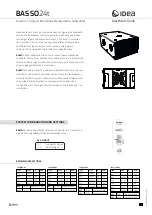
4
ENGLISH
3.2 DB1D, DB2D and DB3D Foot Options
DB1D, DB2D and DB3D subwoofers can be fitted
with either rubber or spike feet – both are supplied
in the accessory pack. Spike feet are designed
to pierce carpet and rest on the floor beneath
both to protect the carpet from indentation and
to provide the subwoofer with a solid foundation.
We recommend that spike feet are used whenever
possible.
Note: Spike feet can be used on delicate, non-
carpeted floors by standing the spikes on coins.
To fit either foot option, a DB1D, DB2D or DB3D
subwoofer must first be turned upside-down. Take
care not to damage the drive units when handling
the subwoofer, and ensure when upside-down
that the subwoofer rests on a surface that will not
damage its finish. Fit either the spike or rubber feet
by screwing them into the four screw holes in the
subwoofer underside. In both cases, initially screw
the lock nuts fully onto the thread of the feet before
screwing them into the subwoofer. Hand tighten the
feet. Diagram 2 illustrates fitting and using spike or
rubber feet.
Once the spike or rubber feet are fitted, the
subwoofer can be turned back on to its feet.
Take care not to allow the entire weight of the
subwoofer to rest at an angle on one or two feet
as it is turned. Also take care that careless handling
of the subwoofer with spike feet fitted does not
cause injury.
If the subwoofer rocks when placed on the floor in
its final position, or the thickness of carpet means
that the spike points do not reach the floor beneath,
adjust the relevant feet until the subwoofer is
supported firmly without rocking. When adjustment
is complete, tighten all the lock nuts against the
underside of the subwoofer using a 10mm spanner.
3.3 Connections
DB1D, DB2D and DB3D subwoofers require
connection to the mains supply and and input signal.
Connectors for optional 12V trigger and RS232
(home automation) are also provided. A variety of
different power cables may be packed with your
subwoofer. Use the one appropriate for the mains
outlet socket in your territory. The subwoofer will
enter standby mode as soon as it is connected to
mains power. Diagram 3 illustrates the DB1D, DB2D
and DB3D subwoofer connection panel.
DB1D, DB2D and DB3D subwoofers provide stereo
RCA Phono and stereo balanced XLR inputs. Their
use is described in the following paragraphs. It is
possible to use the Phono and XLR sockets as
independently selectable inputs. This potentially
enables your DB1D, DB2D or DB3D subwoofer to
be integrated with two different audio systems – a
home theatre and a conventional stereo system for
example. Input selection is managed via the Sub
app.
1. Input 1 – Balanced XLR inputs
The balanced XLR inputs are intended for use with
preamplifiers or audio-visual processors that provide
balanced stereo outputs.
Note: Balanced connection, where negative,
positive and ground signals are carried on
separate wires, is common in professional
and some high-end domestic audio equipment.
Balanced connection is inherently more
resistant to interference and noise than
unbalanced connection.
2. Input 2 – Unbalanced Phono inputs
The unbalanced Phono inputs are intended for use
with preamplifiers or audio-visual processors that
provide unbalanced balanced stereo outputs.
Use an appropriate high quality interconnect cable to
connect to the required input or inputs.
Note: If your preamplifier or audio-visual
processor provides only a mono subwoofer
output, it can be connected to just one of
the DB1D, DB2D and DB3D subwoofer
input sockets.
In addition to the mains and signal input sockets
the the DB1D, DB2D and DB3D connection panel
carries the following further sockets:
Diagram 3
Connection panel
1
2
3 4
5
Diagram 2
Fitting spike or rubber feet
3. 12V Trigger 1 – 3.5mm jack socket
The Trigger 1 socket enables wired remote control of
the DB1D, DB2D and DB3D switch on and standby
functions.
4. 12V Trigger 2 – 3.5mm jack socket
The Trigger 2 socket enables wired remote control of
DB1D, DB2D and DB3D preset selection.
5. RS-232 – 9-pin D connector
The RS232 interface enables DB1D, DB2D and DB3D
subwoofers to be incorporated in remote control home
automation systems. Your Bowers & Wilkins retailer
will be able to provide more information RS232 based
home automation systems.

























